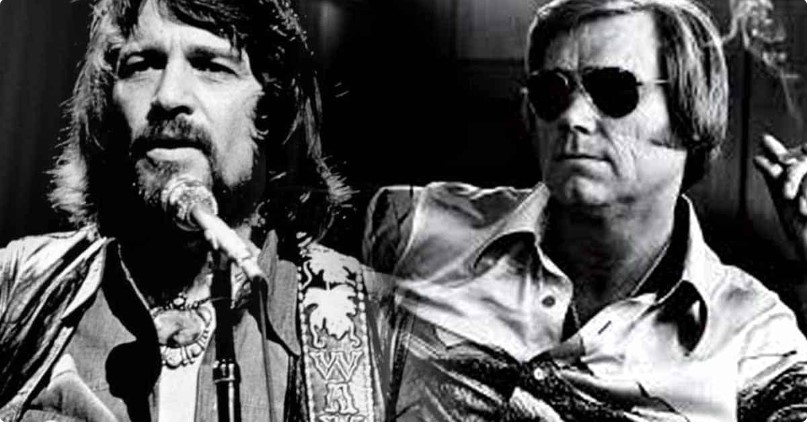
When George Jones and Waylon Jennings joined forces to record Willie Nelson’s timeless classic “Night Life,” it wasn’t just another country duet—it was a moment in history that united three of the genre’s greatest icons. The song, originally penned by Nelson in 1959 and popularized by Ray Price in 1963, found new life decades later through the raw emotion and grit of Jones and Jennings. Their rendition became a symbol of country music’s enduring soul—authentic, weary, and profoundly human.
A Collaboration Between Country Titans
In 1979, George Jones released My Very Special Guests, an album that took nearly two years to complete. Each track paired “The Possum” with a different star, but it was his collaboration with Waylon Jennings on “Night Life” that stood out. At that time, Jones was battling personal demons—alcohol and cocaine addiction—that had taken a toll on his health and voice. Yet, when he stepped into the studio alongside Jennings, the magic was undeniable.
Producer Billy Sherrill later revealed that recording with Jones during this period was a painstaking process. Some songs took months, even up to a year, to finalize because Jones struggled to stay consistent vocally. But despite the chaos surrounding his life, his voice still carried the unmistakable pain, wisdom, and experience that defined his career. When paired with Jennings’ deep outlaw tone, the result was electrifying.
The Story Behind “Night Life”
Willie Nelson wrote “Night Life” long before fame found him. While struggling as a songwriter in Houston, he penned the haunting lyrics: “The night life ain’t no good life, but it’s my life.” The song captures the bittersweet truth of a musician’s existence—the loneliness of endless bars, neon lights, and fleeting love.
Nelson sold the rights to “Night Life” for just $150, a decision he later regretted, as the song went on to become one of his signature compositions. When Ray Price recorded it in 1963, it became a hit and an anthem for late-night wanderers. By the time George Jones and Waylon Jennings revisited it, the song had already earned its place in the canon of American music. Their version, however, gave it a new dimension—grittier, more personal, and soaked in the kind of experience only time and struggle can bring.
Recording During Turbulent Times
Jones’ life in the late 1970s was a storm of turmoil. Despite being one of country music’s greatest voices, he was often unreliable, missing shows and studio sessions due to addiction. Yet, producer Billy Sherrill refused to give up on him. My Very Special Guests became both a challenge and a triumph, as Sherrill pieced together vocals recorded months apart to complete the album.
Working with Waylon Jennings added a different energy. Jennings, a leader of the outlaw country movement, was known for his independence and creative defiance. He brought structure and a sense of camaraderie to the session, encouraging Jones when he needed it most. The chemistry between the two legends was immediate—their voices, though distinct, complemented each other perfectly. Jennings’ rugged baritone grounded Jones’ soaring tenor, creating a performance that was both soulful and haunting.
A Song That Mirrors Real Life
“Night Life” wasn’t just a song for George Jones—it was a reflection of his reality. The lyrics about finding solace in the darkness, about a man who lives for the night because the day brings too much pain, could have been written about him. When Jones sang, “Listen to the blues they’re playing, listen to what the blues are saying,” he wasn’t interpreting someone else’s story; he was living it.
Waylon Jennings, too, understood that world. Both men had walked the line between fame and destruction. Together, they transformed “Night Life” into something more than a cover—it became a confession, a shared truth from two men who had seen the cost of chasing the dream.
The Legacy of “My Very Special Guests”
Released by Epic Records in 1979, My Very Special Guests was an ambitious project that brought together Jones with friends like Elvis Costello, Tammy Wynette, James Taylor, and Linda Ronstadt. But among the star-studded collaborations, “Night Life” stood as a shining example of country authenticity.
Critics have often described this duet as one of the purest moments on the album. It captured not just musical brilliance, but emotional honesty—a quality often lost in overproduced recordings. The imperfections in Jones’ delivery only added to the charm, proving that country music’s strength lies in its ability to tell the truth, no matter how painful it may be.
Willie Nelson’s Enduring Influence
No discussion of “Night Life” would be complete without acknowledging Willie Nelson’s genius. His songwriting style—simple yet profound—has influenced generations of artists. The fact that a single song could connect Nelson, Price, Jones, and Jennings speaks to its timeless power. Each version reflects the era and personality of its interpreter, but they all share the same emotional core.
Nelson’s vision of “night life” as both a burden and a sanctuary resonates deeply with anyone who has chased dreams in the face of hardship. Jones and Jennings brought that duality to life with their rendition, infusing it with world-weariness and understanding that only comes from experience.
A Timeless Performance That Defines Country Soul
More than four decades later, the George Jones and Waylon Jennings duet on “Night Life” remains one of country music’s most revered collaborations. It stands as a reminder of what makes the genre so powerful—its capacity to blend storytelling, emotion, and truth in perfect harmony.
Their voices carry the scars of a hard-lived life, yet they also deliver hope. In every note, you hear the struggle, the love for the music, and the resilience that kept them going. It’s a performance that transcends time, capturing the essence of what real country music is all about.
“Night Life” was never just a song—it was a statement. When George Jones and Waylon Jennings sang it, they weren’t merely performing—they were confessing. And in doing so, they etched their names even deeper into the heart of country music history.